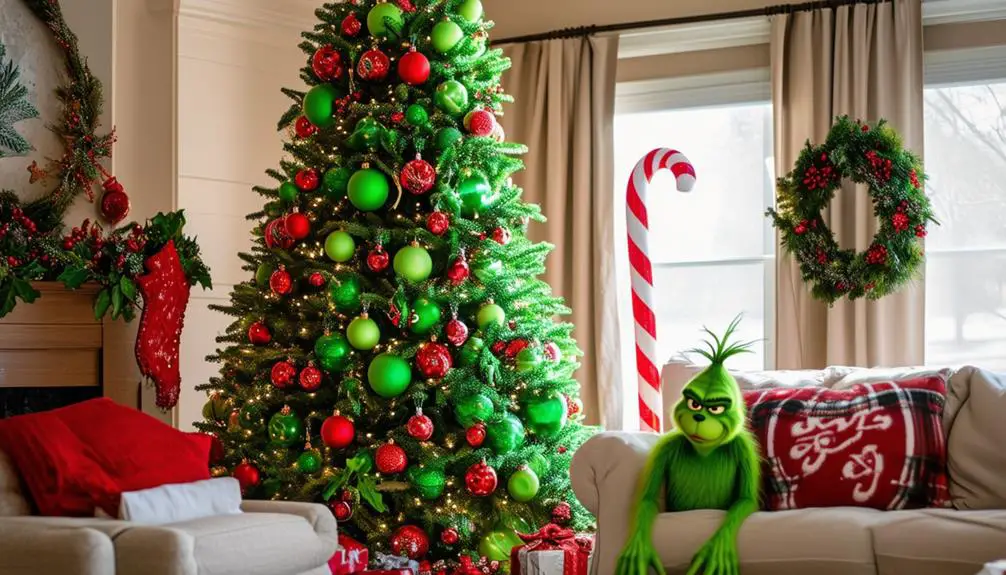As you envision your succulent rock garden, you're likely thinking about more than just plopping some plants into a bed of rocks. You want a harmonious blend of texture, color, and form that showcases these hardy plants. But where do you start? By selecting the right succulents for your climate and lighting, you'll set the stage for a thriving garden. Now, imagine combining these with a curated selection of rocks and pebbles that add depth and visual interest. You're just getting started, and the possibilities are endless – but what's the secret to balancing it all?
Choosing the Right Succulents
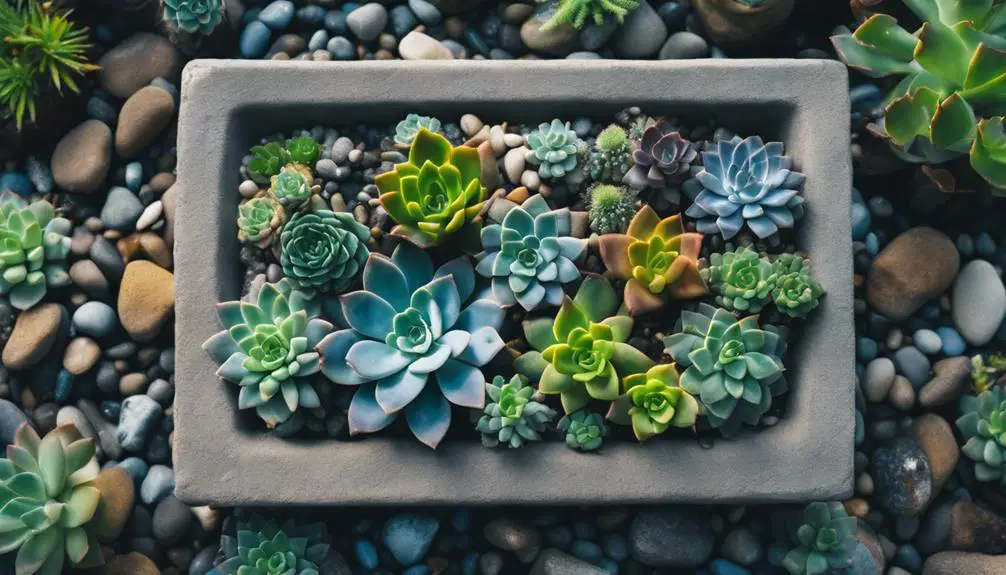
When selecting succulents for your rock garden, consider the specific growing conditions and the overall aesthetic you want to achieve, as different species thrive in various lighting, temperature, and watering conditions.
You'll want to choose succulents that are compatible with each other in respect of their needs, guaranteeing a harmonious coexistence.
For instance, if you're designing a garden that receives full sun, opt for succulents like Aloe, Echeveria, and Crassula, which can tolerate high temperatures and intense light.
On the other hand, if your garden receives partial shade, consider succulents like Haworthia, Sedum, and Peperomia, which prefer milder conditions.
When it comes to succulent selection, think about the visual appeal you want to create.
Do you want a dramatic, architectural look with tall, columnar succulents like Euphorbia, or a soft, rounded appearance with smaller, rosette-forming succulents like Sempervivum?
Consider the colors, textures, and shapes of the succulents you choose to guarantee a cohesive look.
Selecting Rocks and Pebbles
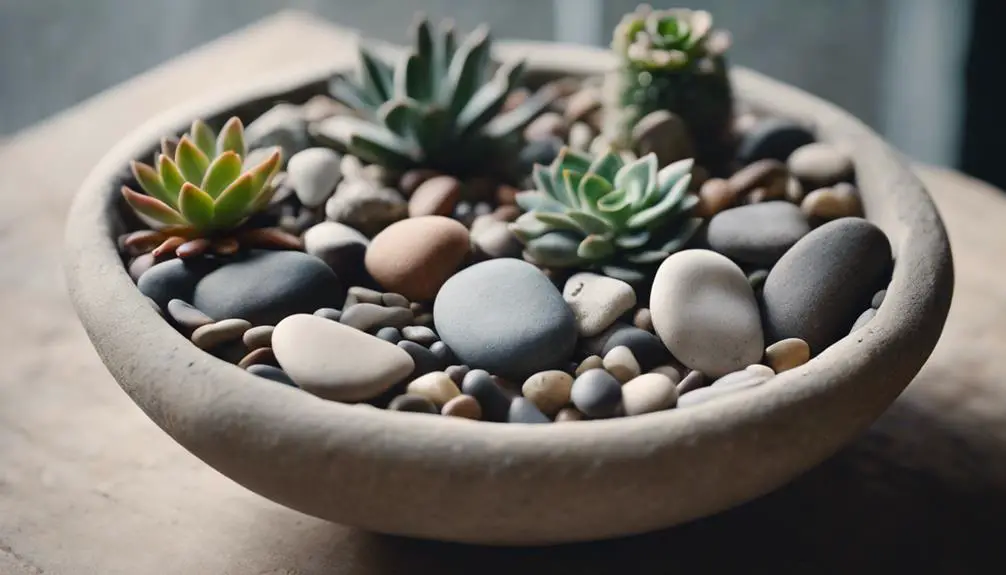
As you start selecting rocks and pebbles for your succulent rock garden, you'll want to ponder the diverse range of rock types and textures that can add depth and visual interest to your design.
You'll also need to think about the size and color options that will complement your chosen succulents and create a cohesive look.
Rock Types and Textures
You'll want to curate a diverse assortment of rocks and pebbles that vary in texture, color, and size to create a visually appealing succulent rock garden.
When it comes to rock types, you'll find that different formations offer unique characteristics. Igneous rocks, formed from cooled magma, often feature a coarse, porous texture.
Sedimentary rocks, composed of compressed minerals, can display layered patterns and subtle color variations. Metamorphic rocks, altered by heat and pressure, may exhibit intricate veining or swirling patterns.
When selecting rocks, consider the quarrying process, which can impact the rock's appearance. Rocks extracted from underground quarries may retain their natural, rough-hewn texture, while those from above-ground quarries might be more refined.
You may also encounter rocks with a weathered, patina-like finish, which can add character to your design. By incorporating a variety of rock types and textures, you'll create a dynamic, visually engaging succulent rock garden that celebrates the beauty of geological wonders.
Size and Color Options
Selecting rocks and pebbles in a range of sizes and colors will add depth and visual interest to your succulent rock garden, allowing you to create a unique, layered landscape that complements your chosen succulent varieties.
When choosing rocks and pebbles, consider the sizes of your succulents. Larger rocks can provide a striking contrast to smaller succulent sizes, while smaller pebbles can create a cohesive look with similarly sized plants. You can also use a mix of sizes to create a visually appealing gradient effect.
Color schemes are also vital in selecting rocks and pebbles. Neutral tones like beige, gray, and brown can blend seamlessly with a variety of succulent colors, while bolder options like red, orange, and yellow can add a pop of color to your design. Consider the natural colors of your succulents and choose rocks and pebbles that complement or contrast with them.
Pebble Patterns and Layout
To create a visually stunning succulent rock garden, arrange your rocks and pebbles in a pattern that complements the shapes and textures of your chosen succulents.
You'll want to balance large rocks with smaller pebbles to create visual interest. Consider creating pebble pathways that meander through your garden, guiding the viewer's eye to focal points.
For pattern inspiration, look to nature – the swirling patterns of sand dunes, the spiral shapes of seashells, or the geometric patterns found in rocks themselves.
You can also draw inspiration from architectural elements, like the intricate mosaics found in Moroccan tiles or the clean lines of modern design.
As you lay out your rocks and pebbles, experiment with different patterns and layouts until you find one that feels cohesive and visually appealing. Don't be afraid to move things around – it's all part of the design process.
With a little creativity and experimentation, you'll create a succulent rock garden that's truly one-of-a-kind.
Preparing the Garden Site
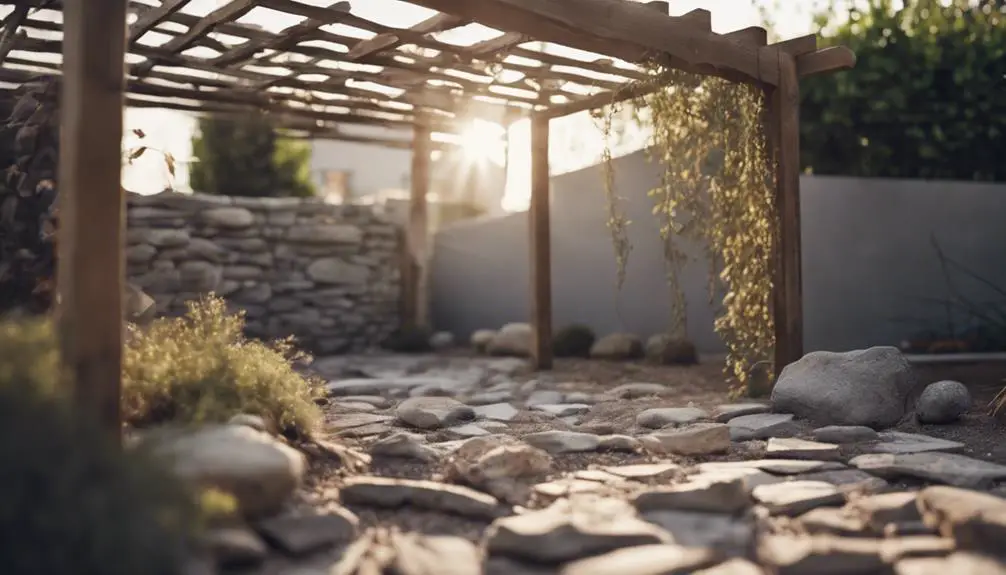
As you prepare to create your succulent rock garden, you'll need to assess the site you've chosen, taking note of the amount of sunlight it receives, the soil type, and any potential drainage issues.
Next, you'll need to prepare the garden bed, which may involve removing existing grass or weeds, tilling the soil, and adding organic matter to improve its structure.
Site Assessment Needed
Before designing your succulent rock garden, you must conduct a thorough site assessment to identify the specific conditions of your outdoor space, including the amount of sunlight, soil type, and existing drainage patterns.
This essential step will help you understand the site limitations that may impact your garden's success. Take note of the environmental factors that will influence your design, such as wind direction, temperature fluctuations, and humidity levels.
Observe how the sunlight falls on your space throughout the day, and identify any areas that receive full sun, partial shade, or full shade.
Test the pH level and nutrient content of your soil to determine if it's suitable for succulents. Also, inspect the drainage patterns to prevent waterlogged soil, which can be detrimental to your plants.
Garden Bed Preparation
With your site assessment complete, you're now ready to prepare the garden bed by removing any debris, weeds, or unwanted vegetation that may compete with your succulents for water and nutrients.
This step is vital in creating a thriving succulent rock garden. Begin by clearing the area of any obstructions, then use a shovel or garden fork to loosen the soil to a depth of about 12 inches.
Remove any weeds or debris, taking care not to damage the soil structure. If you haven't already, consider conducting a soil test to determine the pH level and nutrient content of your soil.
This will help you choose the right succulents and amendments for your garden. Once the soil is clear, apply a layer of organic mulch to help retain moisture, suppress weeds, and regulate soil temperature.
The importance of mulch can't be overstated, as it will greatly benefit your succulents' health and growth.
With your garden bed prepared, you're now ready to start designing your succulent rock garden.
Designing the Garden Layout
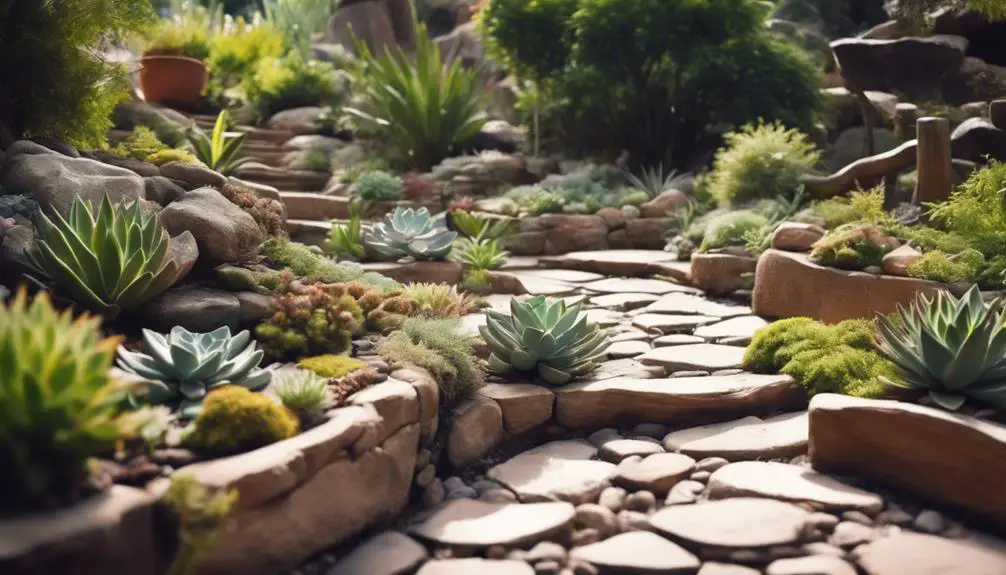
You'll need to visualize the overall aesthetic and functionality you want to achieve in your succulent rock garden, carefully balancing negative space, texture, and color to create a visually striking arrangement.
This is where you'll establish garden harmony by considering the relationships between your succulents, rocks, and surrounding landscape.
To achieve visual flow, imagine a path that guides the viewer's eye through your garden.
This can be achieved by creating a sense of movement using curved lines, repetitive patterns, or gradual changes in texture and color.
As you plan your layout, think about the mature size of your succulents and leave enough space for them to grow.
Consider grouping similar plants together or creating a gradient of textures and colors to add depth and interest.
Don't forget to incorporate rocks and other decorative elements in a way that complements your succulents, rather than overpowering them.
Creating a Focal Point

A show-stopping centerpiece or striking succulent arrangement serves as a magnetic focal point, drawing the viewer's eye into your rock garden and setting the tone for the entire design.
When creating a focal point, consider the visual anchors that will guide the viewer's gaze. You can achieve this by placing the focal point off-center, about one-third of the way into the garden. This placement creates visual tension, encouraging the viewer to explore the rest of the garden.
Think about the scale and proportion of your focal point in relation to the rest of the garden. A large, dramatic arrangement will draw attention, while a smaller, more subtle focal point can create a sense of intimacy.
Consider the colors, textures, and forms of your succulents and how they'll interact with the surrounding rocks and gravel. By carefully selecting and placing your focal point, you'll create a visually appealing anchor that draws the viewer in and sets the stage for the rest of your rock garden design.
Adding Decorative Elements

As you design your succulent rock garden, you'll want to incorporate decorative elements that accentuate its natural beauty.
You'll start by selecting rock accents and pebbles that complement your succulents' unique textures and colors.
Next, you'll add decorative garden ornaments that add visual interest and personality to your outdoor space.
Rock Accents and Pebbles
Decorative rock accents and pebbles add a visually striking contrast to the lush, vibrant succulents in your rock garden, drawing the eye to specific areas of interest.
By incorporating rock formations, you'll create a natural, organic look that complements your succulents. For instance, you can create a striking focal point by grouping large rocks together or use smaller rocks to create a meandering pathway.
Pebble pathways, on the other hand, add a touch of whimsy and playfulness to your design. You can use pebbles in varying colors and textures to create a unique, eye-catching pattern.
Consider using a mix of light and dark pebbles to create a striking contrast or use large pebbles to create a 'river' effect. When selecting rock accents and pebbles, choose materials that complement the colors and textures of your succulents.
Remember to balance your design by distributing the rock accents and pebbles thoughtfully throughout your garden. By doing so, you'll create a visually appealing and harmonious succulent rock garden that showcases your creative flair.
Decorative Garden Ornaments
With your rock accents and pebbles in place, you're ready to elevate your succulent rock garden by incorporating decorative garden ornaments that inject personality and style into your design.
These ornaments can add a touch of whimsy, sophistication, or playfulness, depending on your personal taste.
Consider succulent statues that double as planters, adding an extra layer of visual interest to your garden.
For a more lighthearted approach, garden gnomes can bring a smile to visitors' faces.
When selecting ornaments, guarantee they complement your succulents' shapes, sizes, and colors.
Avoid overwhelming the space with too many ornaments; instead, choose a few statement pieces that create a focal point.
You can also repurpose items like seashells, driftwood, or vintage garden tools to create unique, eclectic decorations.
Remember to balance your ornaments with the natural beauty of your succulents, allowing each element to shine.
Incorporating Hardscaping Features
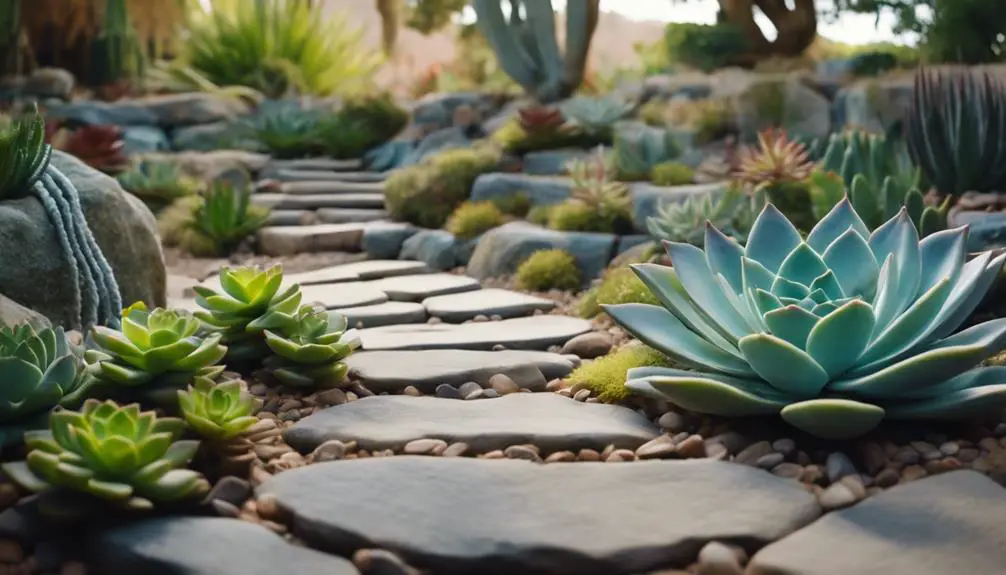
You'll need to thoughtfully balance your succulent selection with strategic hardscaping elements to create a visually striking rock garden.
Succulent integration is key, as it allows you to create a harmonious blend of textures, colors, and forms.
By incorporating hardscape features, such as rocks, gravel, and concrete, you can create a striking contrast that elevates your succulent arrangement.
Hardscape contrast is essential in creating visual interest and depth in your rock garden.
Consider using different textures, such as rough-hewn rocks and smooth gravel, to add dimension and contrast.
You can also use hardscaping elements to create a sense of movement and flow, guiding the viewer's eye through the garden.
For example, a meandering path made of small stones can lead the viewer to a focal point, such as a statement succulent or decorative ornament.
Soil and Drainage Considerations
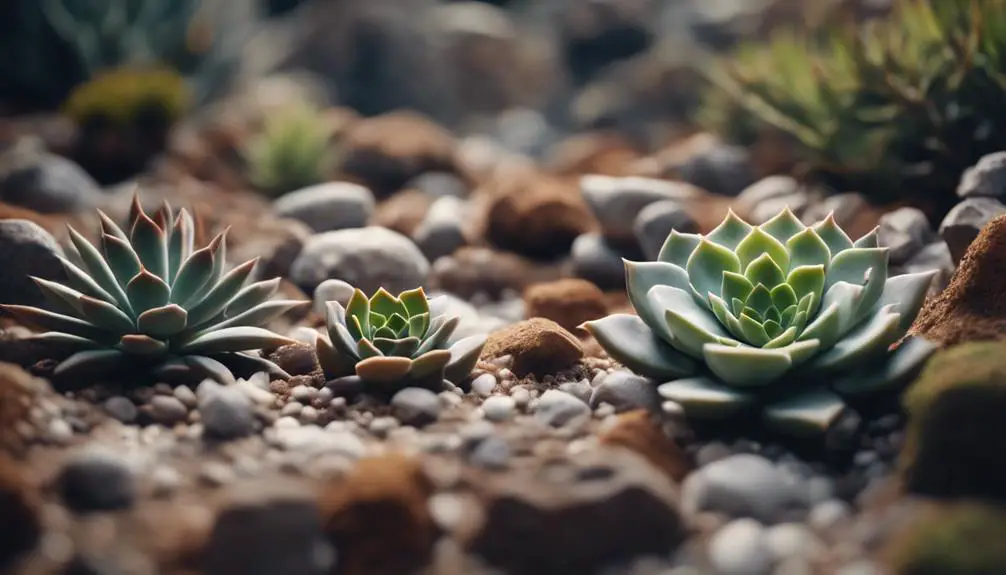
As you design your succulent rock garden, careful consideration of soil and drainage is essential to ensuring the health and longevity of your plants.
Succulents thrive in well-draining soil with a slightly acidic to neutral pH, between 6.0 and 7.0. Test your soil pH and amend it if necessary to create an ideal environment for your succulents. A mix specifically designed for cacti and succulents is a good starting point.
Effective drainage systems are also pivotal, as succulents are prone to root rot in waterlogged conditions.
Incorporate a drainage layer, such as perlite or vermiculite, into your soil mix to improve water penetration and aeration. You can also design a drainage system that directs excess water away from the plants, using materials like gravel or crushed stone. Consider installing a French drain or a swale to collect and redirect water.
Planting and Spacing Succulents
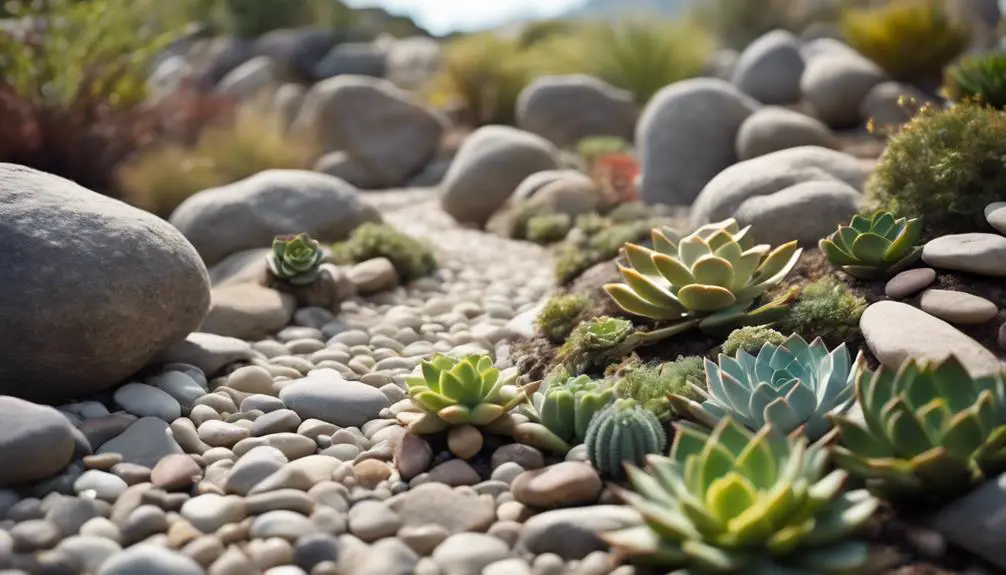
Select a Succulent Variety That Fits Your Garden's Conditions and Aesthetic, Then Plant It at the Same Depth It Was Previously, Making Sure the Soil Level Sits Just Above the Roots.
When planting, gently remove the succulent from its pot, taking care not to disturb the roots. If your succulent is pot-bound, gently tease the roots apart with your fingers to encourage spreading.
When spacing succulents, consider creating succulent clusters to add visual interest to your rock garden. Plant smaller succulents around larger, statement pieces to create a visually appealing arrangement.
Use focal anchors, such as large boulders or statement succulents, to draw the eye to specific areas of the garden. When grouping succulents, leave enough space between each plant to allow for proper air circulation and growth.
A general rule of thumb is to space succulents 1-3 inches apart, depending on the mature size of the plant. By carefully selecting and spacing your succulents, you'll create a beautiful, thriving rock garden that showcases these stunning plants.
Watering and Maintenance Tips
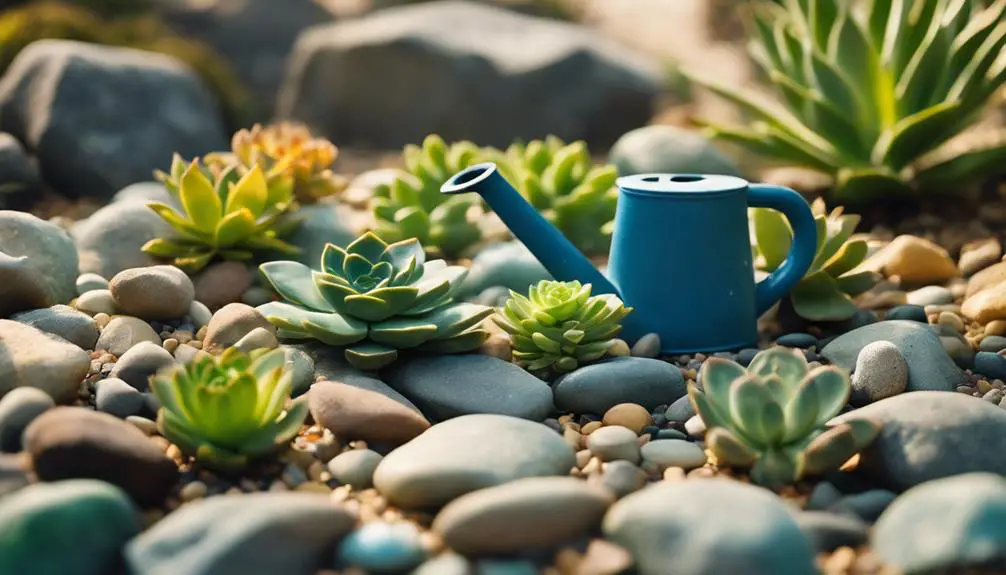
Watering your succulent rock garden requires a delicate balance, since these plants thrive in dry conditions but still need occasional hydration to survive.
You'll want to establish a watering schedule that takes into account the specific needs of your plants, as well as the climate and soil conditions in your garden.
A general rule of thumb is to water your succulents when the soil is dry to the touch, usually every 7-10 days during the spring and summer months.
To facilitate efficient watering, consider investing in an irrigation system that delivers water directly to the roots of the plants.
This will help prevent evaporation and runoff, and reduce the risk of overwatering.
When you do water, make sure to soak the soil thoroughly, allowing excess water to drain away.
Avoid getting water on the leaves or stems to prevent rot and other diseases.
Regular maintenance is also vital to keep your succulent rock garden thriving.
Remove any dead or damaged plants, and trim back overgrown stems to encourage new growth.
Add a layer of organic mulch to retain moisture and suppress weeds.
Dealing With Pests and Diseases
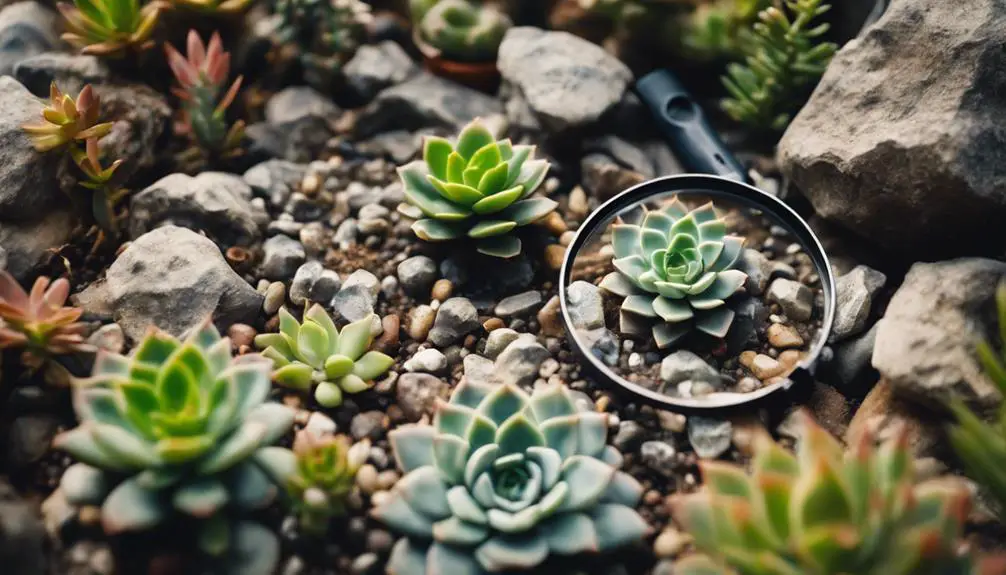
While your succulent rock garden is thriving, it's not immune to pests and diseases, which can quickly spread and decimate your plants if left unchecked.
To prevent this, you'll need to implement effective pest management strategies. Start by monitoring your plants regularly for signs of infestation, such as white powdery patches, sticky residue, or actual pests like mealybugs or spider mites.
Isolate infected plants immediately to prevent the spread of disease.
For fungal infections, treat with fungicides specifically designed for succulents. Remove any affected leaves or stems to prevent the infection from spreading.
Improve air circulation around your plants by pruning nearby rocks or adding space between plants. Guarantee good drainage to prevent waterlogged soil, which can exacerbate fungal infections.
Consider introducing natural predators, like ladybugs, to control pest populations.
Succulent Rock Garden Styles
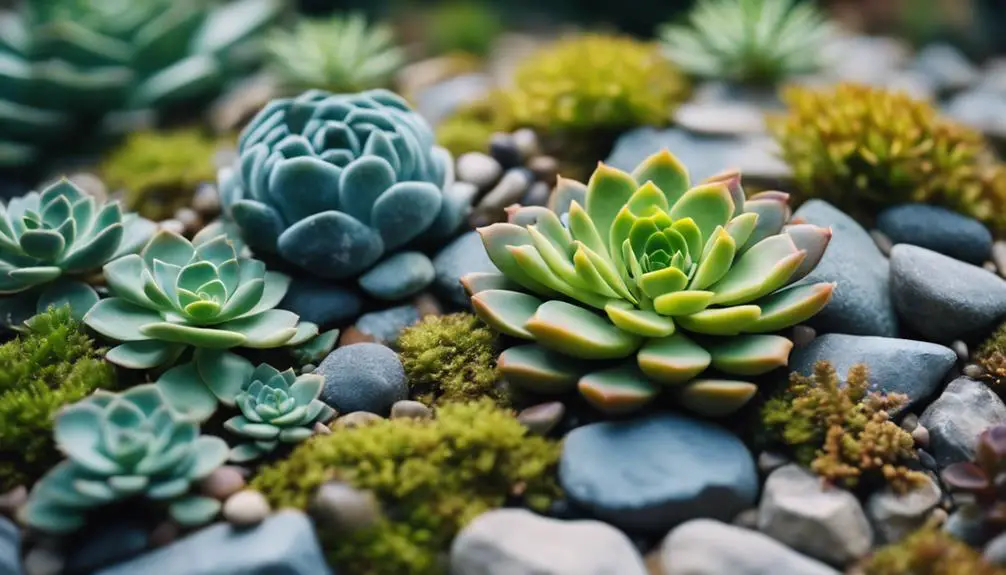
As you design your succulent rock garden, you'll want to ponder the style that best suits your space and personal taste, whether it's a modern, architectural landscape or a whimsical, free-form arrangement.
Succulent rock gardens can evoke a range of styles, from the dramatic, monolithic forms of desert landscapes to the soft, weathered tones of coastal vibes.
For a modern look, consider a geometric layout with clean lines, bold succulent varieties, and minimal ornamentation.
Alternatively, you can create a whimsical arrangement by mixing and matching different succulent species, shapes, and sizes, and incorporating natural elements like driftwood or pebbles.
If you're drawn to the desert aesthetic, think cacti and succulents with sharp, angular shapes, paired with rocks and gravel in warm, earthy tones.
For a coastal vibe, opt for softer, more rounded succulent forms, paired with weathered wood, shells, or smooth pebbles.
Ultimately, your succulent rock garden style will depend on your personal taste and the unique characteristics of your space.
DIY Succulent Rock Garden Ideas
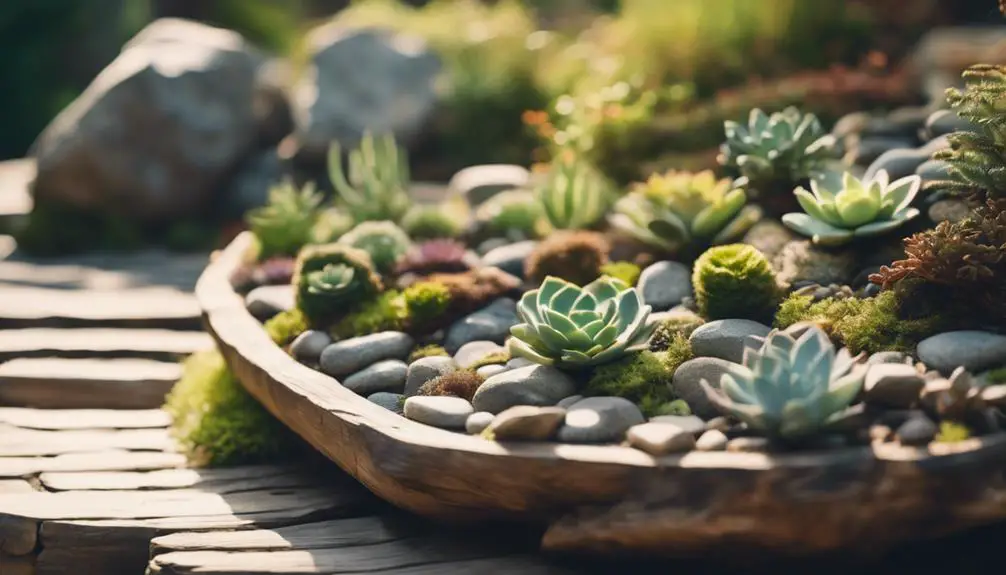
Now that you've established your succulent rock garden style, it's time to get creative and bring your vision to life with these inspiring DIY ideas that cater to your unique space and budget.
One innovative approach is to create mini gardens within your rock garden. Use small, shallow containers or even repurposed items like teapots or boots to create individual succulent habitats. This technique allows you to experiment with different soil types, succulent species, and decorative elements, adding visual interest to your overall design.
Another DIY idea is to incorporate vertical planters into your rock garden. This space-saving technique is perfect for small yards or balconies.
Simply attach a trellis or a wall-mounted planter to your outdoor wall, and fill it with a mix of succulents and rocks. This will add depth and dimension to your design while keeping maintenance to a minimum.
Frequently Asked Questions
Can I Use Succulents From My Indoor Pots in the Rock Garden?
You can repot your indoor succulents in the rock garden if they're hardy enough, but first, assess their hardiness and pot size – if they're small and adapted to outdoor conditions, it's a great way to upcycle and add variety to your design.
How Often Should I Fertilize My Succulent Rock Garden?
When fertilizing your succulents, remember they have different nutrition needs than other plants. Fertilize sparingly, as over-fertilization can harm them. For ideal growth, fertilize during the active growing season, typically spring and summer, using a balanced, water-soluble fertilizer.
Will Deer and Rabbits Eat My Succulent Plants?
You'll likely face wildlife threats, as deer and rabbits find succulents tasty. To protect your plants, you'll need to implement effective wildlife deterrents and pest control methods, such as fencing, repellents, or physical barriers to safeguard your garden.
Can I Create a Succulent Rock Garden in a Shaded Area?
You can create a stunning garden in shaded areas by selecting shade-tolerant succulents and using lighting alternatives like grow lights or mirrors to amplify available light, ensuring your plants thrive in low-light conditions.
Are Succulent Rock Gardens Suitable for Wheelchair Accessibility?
When designing an accessible garden, you'll want to incorporate ramped pathways and accessible planters, ensuring wheelchair users can navigate and engage with the space; with careful planning, you can create an inclusive oasis that's both beautiful and functional.
Conclusion
As you step back to admire your succulent rock garden, remember that it's a dynamic, evolving entity.
With careful planning and attention, it will thrive, adapting to the rhythms of nature.
By balancing texture, color, and form, you've created a visually stunning oasis.
Now, sit back, relax, and watch your miniature masterpiece flourish, its beauty unfolding with each passing day.


